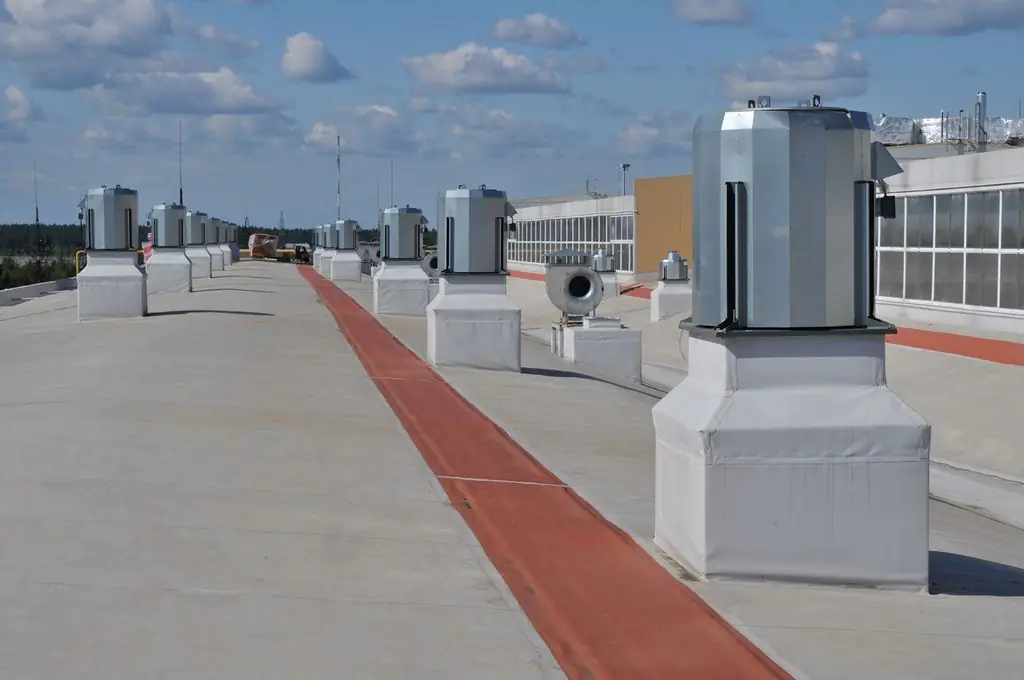
Table of contents:
- Author Bailey Albertson [email protected].
- Public 2024-01-17 22:26.
- Last modified 2025-06-01 07:32.
How to choose a membrane for the roof and install it yourself

The tightness and strength of the roof are prerequisites for a comfortable stay in a country house. The popularity of individual construction gives rise to the proposal of new materials and technologies from manufacturers. One of these proposals is membrane films, including for roofs.
Content
-
1 How and how to mount a membrane roof
1.1 Photo gallery: what are the membrane roofs
- 2 Preparation for roofing
-
3 Installation technology
- 3.1 Ballast method
-
3.2 Adhesive bonding
3.2.1 Video: gluing the membrane to a bituminous roof
-
3.3 Warm welding method
3.3.1 Video: installation of a membrane roof
-
3.4 Mechanical fastening of diaphragms
3.4.1 Video: mechanical installation of membrane roofing
-
4 Features of the installation of membrane roof elements
4.1 Photo gallery: types of membrane films
-
5 Installation tool
-
5.1 Hair dryer for membrane roof installation
- 5.1.1 Design and technical characteristics of hair dryers
- 5.1.2 Video: operating experience and the process of choosing a technical or construction hair dryer
-
How and how to mount a membrane roof
Membrane roof coverings are used for flat and low angle roof structures. In this case, it is possible to lay the finishing material on top of the existing old roof during the repair. This significantly reduces the complexity of such work.

The membrane foil can be laid over the old roof covering, having previously leveled and cleaned from dirt
The use of membrane material for flat roofs creates a highly reliable coating with respect to water resistance. This applies, first of all, to films, connected by heat-sealing method. The service life of a membrane roof is up to 50 years if done correctly. For the device of such a roof, the following are used:
- membranes made of PVC - polyvinyl chloride - the most popular material;
- EPDM films based on synthetic rubber (propylene diene monomer);
- TPO membranes are thermoplastic polyolefin containing up to 70% ethylene-propylene rubber and about 30% polypropylene.
In addition, to improve the basic characteristics, many manufacturers introduce fiberglass or polyester threads into the membrane material.
The main properties that make it possible to successfully use membranes for roofs are their plasticity and flexibility. Therefore, they can be used on any slope of the slopes. Such roofs are fire-resistant, have a long service life and can withstand heavy loads.
Photo gallery: what are the membrane roofs
-

Complex membrane roof shape - Roofs of any shape can be covered with membrane material
-

How a membrane roof cake is formed - Correct formation of the roofing pie ensures the durability of the membrane roof
-

Bonding membrane joints - The joints and abutments are soldered using a special tool
-

Ballast installation of membrane roof -
The membrane can only be fixed around the perimeter, on the rest of the surface it will be held with ballast (crushed stone or tiles)
Preparation for roofing
Preliminary measures for the construction of a membrane roof are not particularly difficult. This requires:
- Thoroughly clean the surface from debris, dirt and various layers.
- Measure the surface to be covered and calculate the roof area. When determining the amount of material, the degree of overlap between the membrane sheets during installation must be taken into account. It depends on the material and method of connection at the joints.
-
For the roofing cake, you need to use thermal insulation materials that increase the life of the membranes.

Installation of covering on corrugated board It is not necessary to remove the old coating when installing the membrane.
Installation technology
There are several methods for constructing roofs using membranes.
Ballast method
In this way, a covering is installed on roofs with a slope of no more than 15 degrees. Installation is carried out as follows:
- The membrane is spread over the entire surface of the roof with overlap, carefully leveled.
-
The joints are connected with glue or soldering using special equipment that produces a jet of hot air at a temperature of 400-600 degrees. The membrane is poured onto vertical surfaces and glued in the same way.

Installation of joints and abutments At the joints and abutments, the membrane is soldered with a special welding machine
-
The fixed membrane webs are filled with bulk material - river pebbles, gravel or crushed stone. The thickness of the layer must be such that the load on the membrane is at least 50 kilograms per square meter. Protection against possible damage to the film is a non-woven material that is laid on top of it before backfilling.

Backfilling with rubble Crushed stone is poured onto the membrane spread and glued around the perimeter, which firmly fixes the coating
Adhesive bonding
Installation of membranes on glue is used on roofs of complex shapes or when working in areas with increased wind loads. The membrane is fastened and the joints are processed with specially developed adhesives or double-sided adhesive tapes. Bonding over the entire contact area is not performed, only the butt surfaces and extreme edges are processed.
Mounting adhesive is used if the membrane is laid on:
- Wood.
- Concrete slabs or screed.
- Metal surfaces (corrugated board).
For fixing on vertical surfaces, in addition to glue, clamping strips with seals are used. The installation technology is simple and does not involve the use of special equipment.
This method is quite costly and does not give a full guarantee of long-term operation, therefore it is not used so often in comparison with the others.

Installation of the roof using special adhesives does not always provide the required durability, therefore it is rarely used
Video: installation of the membrane on a bituminous roof using the adhesive method
Warm welding method
Welding is used for PVC and TPO membranes. The joint at the joints and along the perimeter is made by heating with a jet of hot air at a temperature of 400-600 o C. When laying membranes on large areas, professional welding equipment is used that works in automatic mode. The seam width is 3-12 centimeters.
The resulting joints are completely sealed, and the tear resistance of the joint becomes higher than that of a solid membrane.
When working in hard-to-reach places, hand-held construction hair dryers and special equipment are used to press the edges to the installation site.

The joints are heated up to 400-600 degrees, and then rolled with rollers
Video: installation of a membrane roof
Mechanical fastening of membranes
Mechanical fixation of membranes is the most affordable way to do it yourself. It is also used when the rafter system will not support the ballast load. The reason for abandoning the glue method may be the complex shape of the roof, especially in areas with high wind loads.
The best basis for using mechanical fastening is concrete or profiled sheet. When fixing sheets to vertical planes, rails with a seal on the wrong side are used. Fastening along the canvas is made through galvanized self-tapping screws using wide washers. The step of installing the fasteners is no more than 20 centimeters.

Mechanical fastening of the membrane to the concrete surface is carried out with disc-shaped dowel-nails with wide heads
Video: mechanical device of a membrane roof
youtube.com/watch?v=qt4gmwH3h9w
Features of installation of membrane roof elements
The use of membranes for roofing is associated with a number of features, depending on its type and nature of the base.
The following points are important:
- Of particular importance is the choice of the type of membrane covering, taking into account local conditions and the type of roof.
- All types of films are suitable for ballasting.
- When using TPO membranes, the best type of fastening is mechanical, since it does not require the elasticity of the film.
- If the coating web is connected manually by warm welding, you need to choose a film without hardening additives.
- When using a PVC membrane, do not allow the coating to come into contact with substances containing petroleum products, solvents and bitumen. If this condition is not observed, the film may collapse. If there is such a neighborhood, the film must be separated with a layer of expanded polystyrene.
Photo gallery: types of membrane films
-

Polyethylene membrane - In some cases, polyethylene film is the best membrane option.
-

EPDM film - EPDM film is mainly used for covering flat roofs
-

Multi-layer roofing film - Reinforcement of the film significantly increases its strength and durability
-

PVC membrane - PVC membranes perform well at low temperatures and have excellent waterproofing properties
Installation tool
A set of tools for laying a membrane roof on a country house:
- Construction hair dryer with the ability to obtain an air stream with a temperature of up to 600 degrees.
- Brass roller for rolling corners and hard-to-reach places.
- Rubberized roller with heat resistant rubber.
- Construction knife for cutting the film.
- Scissors for cutting corners and rounds from the film, which are installed in places with a three-layer film at difficult joints.
- Drill or hammer drill (when using a mechanical fastening method).
- Bench hammer.
- Diagonal extension for the entire length of the roof.
In the process of work, you may need another common tool, which, as a rule, is available in any farm.

For self-assembly of the membrane film, you must have a hair dryer and a set of knives and rollers
Hair dryer for membrane roof installation
You should pay more attention to the building hair dryer. In the hands of a prudent owner, he can become an irreplaceable tool capable of performing the following functions:
- Dry the joints of the tiles, the joints of the material when applying insulation.
- Remove glue or paint residues from the surface when used together with a spatula.
- Defrost pipes or locks, remove ice from steps and wires, defrost icy water drains.
- Disinfect wooden products from beetles and pests, remove ants from stone walls.
-
Press in or hot solder PVC products.

Soldering PVC foil with a construction hair dryer The construction hairdryer can be used to solder PVC products, including roofing films
- Form surfaces of the desired shape from plexiglass or polycarbonate.
- Solder or unsolder copper pipes on tin or silver solder.
- Sealing pools.
For this tool, you can think of many more different uses, so it can rightfully take a permanent place in the tool cabinet of the home craftsman.
Device and technical characteristics of hair dryers
Construction hair dryers are produced by many manufacturers, but the device is the same for all. The main parts of the hair dryer are:
- Fan motor. Depending on the model, its power can be from 500 to 3,000 watts. Equipped with one or two impellers for air supply. For home use, a tool with a power of about 2,000 watts is sufficient.
- Ceramic base on which the heating element is installed to increase the temperature of the air stream.
- Plastic housing made of heat-resistant material.
- Electronic devices for imparting specific functions and characteristics to an instrument.
The main characteristics of hair dryers:
- The heating temperature of the air jet in most models is from 300 to 650 o C. Products with the ability to set temperatures up to 800 o C. are also offered.
- The performance of hair dryers is determined by the amount of air per minute of operation. Mid-range models deliver up to 650 liters of hot air. The higher the performance of the hair dryer, the greater the range of possibilities when using it.
- Air volume regulation. Not all models have this feature, but it is considered important as it expands the capabilities of the tool.
- A device for maintaining the set temperature of the air flow. An important function to ensure the stable operation of the device for a long time. It protects the tool from overheating.
- Device for rapid cooling of the air stream. A very useful property that allows you to reduce the waiting time for the processed object to cool.
- The presence of a filter on the air intake allows the instrument to be used in a dusty environment and prolongs its service life.
There are many models of building hair dryers. Price indicators also fluctuate in a wide range. You can purchase the simplest model for 900 rubles. The most expensive items will cost 4,800-5,000 rubles. This difference is determined by a set of additional functions and characteristics inherent in a particular device. Considering the possibilities that the hair dryer provides to the home craftsman, such a tool in his arsenal is highly desirable.

The construction hair dryer allows you to perform many complex work, so its presence in the tool kit is highly desirable
If the tool is needed to perform one-time work, it can be rented. At the same time, the rent will be from 250 rubles per day, and there are enough offers on the network.
Video: operating experience and the process of choosing a technical or construction hair dryer
The use of membrane films in suburban construction improves the quality of roofs during initial use and greatly simplifies the repair work. A simple tool and uncomplicated application technology allows even not very advanced people in construction to perform work on their own. Good luck to you too!
Recommended:
Installation And Arrangement Of The Roof And Ceiling Of The Bath + Video
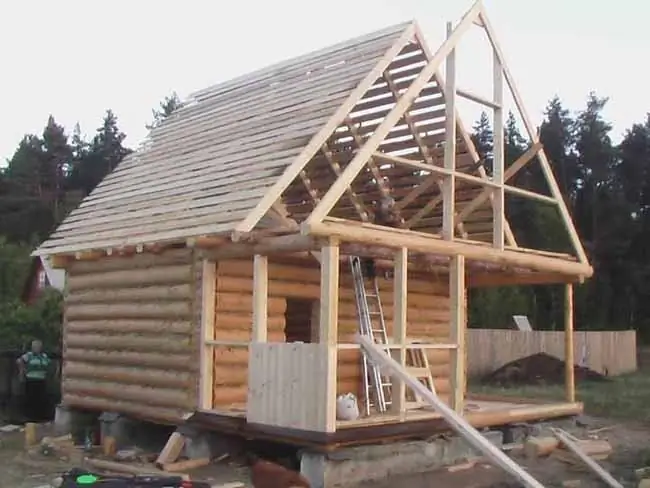
Bath roof installation, bath ceiling. Practical installation recommendations, materials used
Windows 7 Device Manager: Where And How To Open It, What To Do If It Won't Open, Won't Work, Or Is Empty, And If It Doesn't Have Any Ports, Printer, Drive, Monitor Or Video Card

Windows 7 Device Manager. Where to find it, why you need it. What to do if it does not open or if you encounter unexpected problems while working with it
Insulation Of The Roof From The Inside With Foam: Description And Characteristics Of The Material, Installation Stages + Video And Reviews
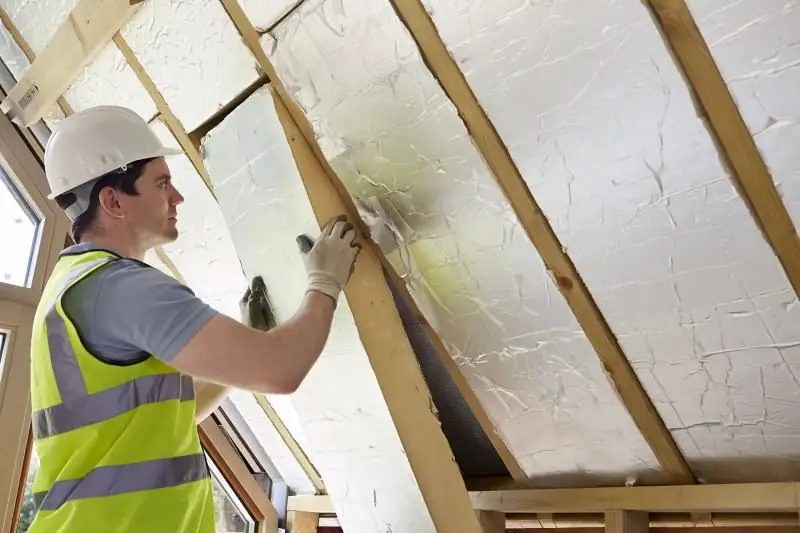
How to choose foam for roof insulation. How to properly form a roofing cake. Styrofoam stacking and cutting methods
Step-by-step Instructions For Self-selection And Installation Of A Toilet, Various Installation Methods + Video
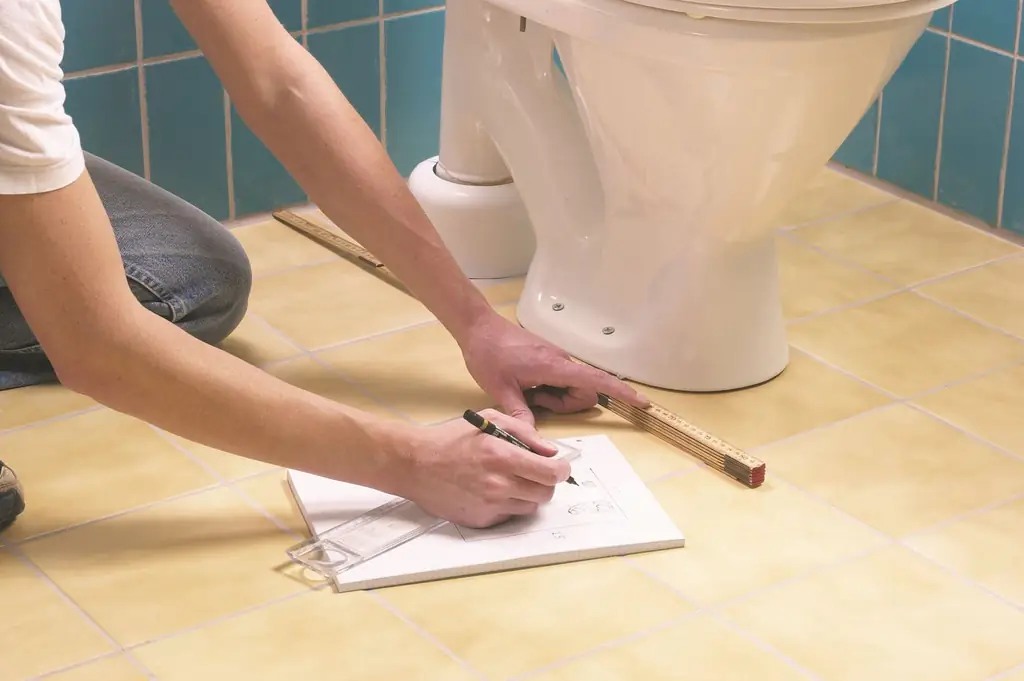
Practical recommendations for self-installation of the toilet. Choosing a suitable toilet bowl, surface preparation. Different ways to install the toilet
DIY Electrical Wiring: Diagram, Tips And Step-by-step Instructions For Installation From Scratch, As Well As Wiring Repair + Video
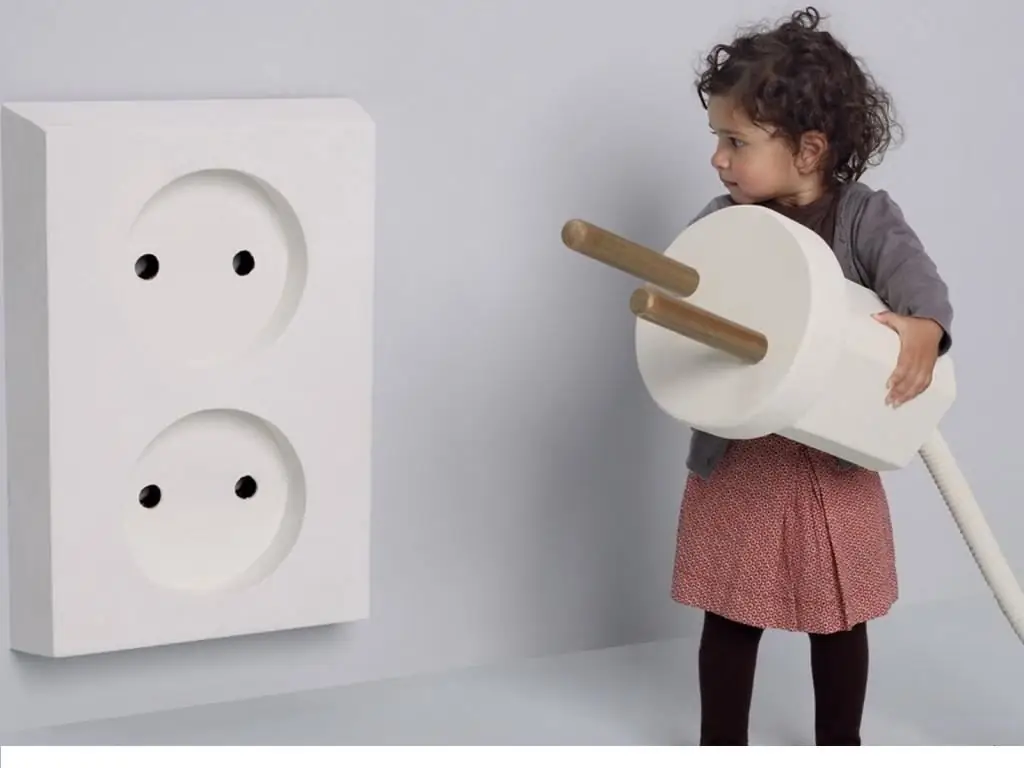
Practical advice on the installation of electrical wiring in an apartment and a private house. Wiring diagram. Installation of hidden and open wiring
